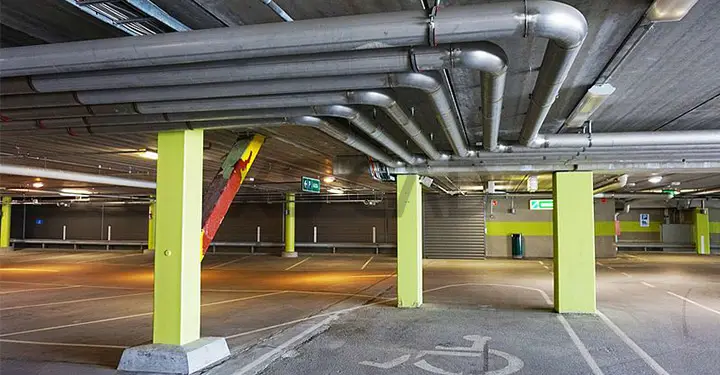Our Articles

Effect of CFD Analysis on Car Park Ventilation
It’s generally a stuffy area to begin with. There’s something vaguely claustrophobic and mildly unpleasant about underground or basement car parks. Imagine how scary a fire would be in such car parks. That’s what makes the design of ventilation systems for car parks so vital. Computational fluid dynamics (CFD) is a field of study that can analyse car park ventilation systems and show the results of fire simulations in these locations. With strict building codes regulating fire systems design in Western countries, CFD simulations created by experienced CFD engineers and supported by HVAC mechanical engineering consultants, this team can help to determine and offer the most effective HVAC design services for optimum air quality and air flow analysis.
Multistorey buildings, shopping malls, hospitals, cinema complexes and other commercial spaces tend to feature indoor car parks, sometimes on multiple levels. General conditions in these spaces involve increased levels of carbon monoxide and carbon dioxide concentrations. In case of fire, large quantities of smoke can be generated at high temperatures resulting in poor visibility, evacuation challenges, breathing difficulties and possible vehicular damage.
An effective ventilation system must be able to quickly and efficiently expel smoke from the area, so that people may escape and so that the area is smoke-free for fire personnel to control and extinguish the fire. Typically, jet fans, or ventilating fans, are used to bring carbon monoxide and carbon dioxide levels under control by continuously fanning fresh air into car parks. In case of a fire, jet fans extract smoke and send fresh air into the space.
To facilitate CFD analysis, flow patterns of the jet fans, the smoke circulation paths, the smoke density, smoke temperature and carbon monoxide/dioxide levels must be determined. Other features studied include the car park layout and the jet fans’ position. A model of the car park is created with scaled dimensions, and the smoke and fire can be modelled mathematically using the large eddy simulation (LES) technique used in Fire Dynamics Simulator.
The location, direction and velocity of the jet fans can determine the optimum air circulation path and strength that is required to expel the smoke effectively, depending on the size and intensity of the fire. Temperature and velocity contours can also be generated.
Sometimes, two jet fans can produce unwanted air circulation due to their locations. This can be avoided by using CFD analysis. The density and spread of smoke can be visualised, so that the visibility in the space during a fire can be determined. A CFD analysis can help refine the ventilation system design, showing where fans can be re-positioned, added or removed.
Process for Fan Installation
Fan thrust determines the spacing between fans. Air velocities of fans in series should be greater than 1m/s. The use of CFD analysis can calculate these distances and determine if they can be achieved in the relevant car park layout. The speed and thrust rating of a fan decides the fan thrust value. It may be more effective to use a greater number of fans with reduced thrust ratings in unusual or irregular car park layouts.
Smoke propagation simulation requires the modelling of heat generated by the fire, buoyancy effects based on temperature, smoke concentration and velocity and pressure variations generated by the HVAC system. A detailed smoke path can be created using CFD, which can show smoke concentration profiles at specific times and from different locations.
Using CFD analysis, the efficiency of the HVAC system during a fire and the movement of smoke towards the exhausts can be checked to optimise fire extinguishment and ensure as clear visibility as possible for those being evacuated, as per local standards. Reports developed may include velocity profiles, temperature/smoke layer profiles for building sections and levels and a standards’ compliance summary.
Computational fluid dynamics, or CFD, is also known as heat transfer. Ultimately, calculations using CFD can help analyse how building exhausts can affect the environment in the following ways:
These CFD calculations and analyses can be generated by using a range of software. Popular software packages used for CFD analysis include the following:
Car park ventilation is of paramount importance to occupants of these buildings, and with the use of CFD calculations, the ventilation in these spaces can achieve optimum efficiency and even be prepared to handle fires that may occur. As an increasing number of Western firms look for offshore solutions to deliver air quality and air flow analysis reports, many Indian outsourcing companies provide viable options. With a wealth of qualified and cost-effective HVAC mechanical engineering consultants available in India, the challenge lies only in finding experienced companies that understand the Western work culture to deliver these analyses promptly and efficiently.

